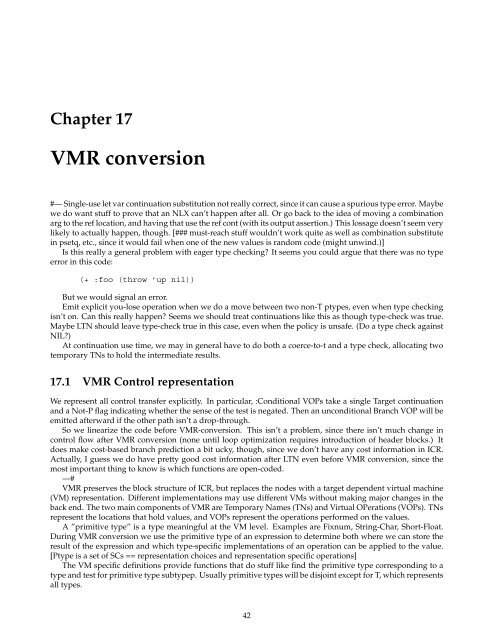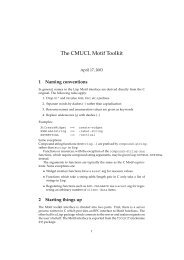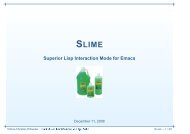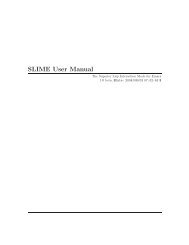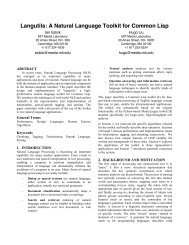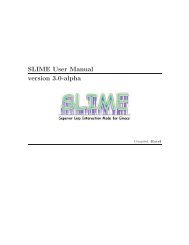Design of CMU Common Lisp.pdf - Common Lisp.net
Design of CMU Common Lisp.pdf - Common Lisp.net
Design of CMU Common Lisp.pdf - Common Lisp.net
Create successful ePaper yourself
Turn your PDF publications into a flip-book with our unique Google optimized e-Paper software.
Chapter 17<br />
VMR conversion<br />
#— Single-use let var continuation substitution not really correct, since it can cause a spurious type error. Maybe<br />
we do want stuff to prove that an NLX can’t happen after all. Or go back to the idea <strong>of</strong> moving a combination<br />
arg to the ref location, and having that use the ref cont (with its output assertion.) This lossage doesn’t seem very<br />
likely to actually happen, though. [### must-reach stuff wouldn’t work quite as well as combination substitute<br />
in psetq, etc., since it would fail when one <strong>of</strong> the new values is random code (might unwind.)]<br />
Is this really a general problem with eager type checking? It seems you could argue that there was no type<br />
error in this code:<br />
(+ :foo (throw ’up nil))<br />
But we would signal an error.<br />
Emit explicit you-lose operation when we do a move between two non-T ptypes, even when type checking<br />
isn’t on. Can this really happen? Seems we should treat continuations like this as though type-check was true.<br />
Maybe LTN should leave type-check true in this case, even when the policy is unsafe. (Do a type check against<br />
NIL?)<br />
At continuation use time, we may in general have to do both a coerce-to-t and a type check, allocating two<br />
temporary TNs to hold the intermediate results.<br />
17.1 VMR Control representation<br />
We represent all control transfer explicitly. In particular, :Conditional VOPs take a single Target continuation<br />
and a Not-P flag indicating whether the sense <strong>of</strong> the test is negated. Then an unconditional Branch VOP will be<br />
emitted afterward if the other path isn’t a drop-through.<br />
So we linearize the code before VMR-conversion. This isn’t a problem, since there isn’t much change in<br />
control flow after VMR conversion (none until loop optimization requires introduction <strong>of</strong> header blocks.) It<br />
does make cost-based branch prediction a bit ucky, though, since we don’t have any cost information in ICR.<br />
Actually, I guess we do have pretty good cost information after LTN even before VMR conversion, since the<br />
most important thing to know is which functions are open-coded.<br />
—#<br />
VMR preserves the block structure <strong>of</strong> ICR, but replaces the nodes with a target dependent virtual machine<br />
(VM) representation. Different implementations may use different VMs without making major changes in the<br />
back end. The two main components <strong>of</strong> VMR are Temporary Names (TNs) and Virtual OPerations (VOPs). TNs<br />
represent the locations that hold values, and VOPs represent the operations performed on the values.<br />
A ”primitive type” is a type meaningful at the VM level. Examples are Fixnum, String-Char, Short-Float.<br />
During VMR conversion we use the primitive type <strong>of</strong> an expression to determine both where we can store the<br />
result <strong>of</strong> the expression and which type-specific implementations <strong>of</strong> an operation can be applied to the value.<br />
[Ptype is a set <strong>of</strong> SCs == representation choices and representation specific operations]<br />
The VM specific definitions provide functions that do stuff like find the primitive type corresponding to a<br />
type and test for primitive type subtypep. Usually primitive types will be disjoint except for T, which represents<br />
all types.<br />
42


